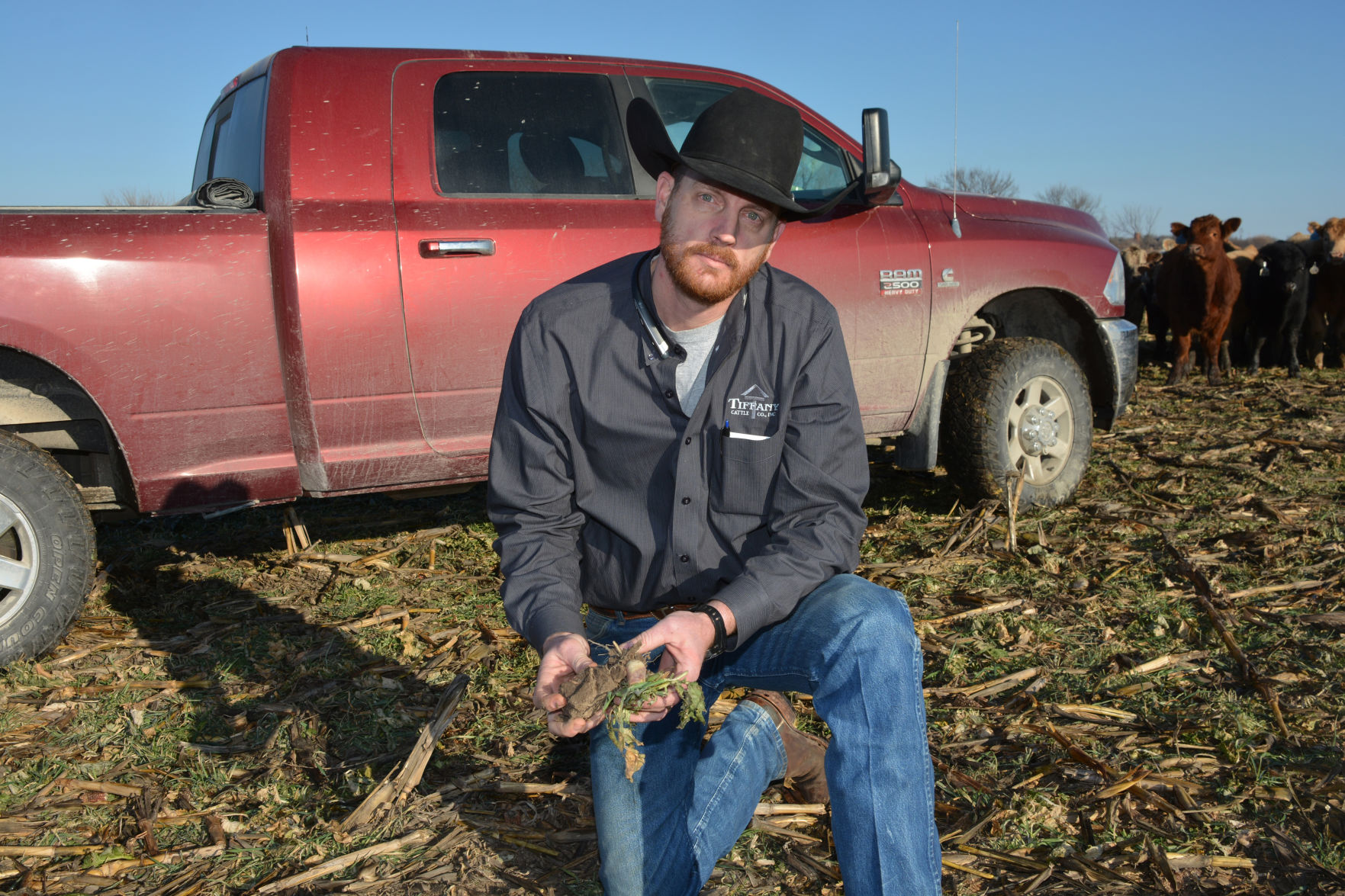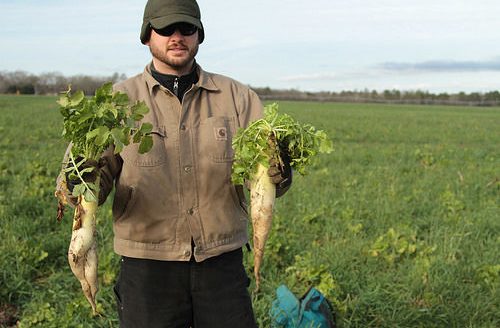Cover crops and soil health are a winning combination at Tiffany Cattle Company

Most feedlot operators don’t necessarily like to be farmers. At Tiffany Cattle Company, however, farming and cattle feeding go hand-in-hand. That’s because brothers Shawn and Shane Tiffany have implemented a cover crop-based grazing system on their nearly 2,500 acres of farmland near Herington, Kansas.
In 2010, three years after the brothers bought the former Black Diamond feedlot, Shawn attended a field day on how cover crops could be part of a grazing system. Shortly thereafter, they began integrating cover crops to the system.
“We were two young guys in a business trying to keep things going and generate revenue. The farmland was strictly another line of business we were going to be able to provide our customers,” Shawn recalled.
“What started out as another line of business has grown into something much bigger.”
Integrating cattle into covers
The Tiffanys feed about 60,000 cattle each year. The animals are fed silage- and corn-based diets grown mostly on their farm operation.
Corn and wheat are the major cash crops, and sorghum silage is used for the feedlot operation. After corn harvest—whether for silage or grain—the Tiffanys plant a blend of cover crop species, often including rye, oats, barley and/or triticale; brassicas including turnips and deep-rooted radishes; and legumes like mung beans and peas. This blend can provide winter grazing for calves before they head to the feedlot. After cattle are removed from the field, Shawn either allows the crop to grow for silage, or the crop is terminated and planted back to corn.
For their feeding operation, cover crop grazing is a growing enterprise in high demand.
“People are lined up at the door to get that particular service we provide,” he said. “We’re putting gain—primarily frame—on these calves and doing it very cheaply.” Those cattle are positioned to come into the feedlot with a frame size and maturity to excel in the finishing phase, he added. And they do excel; in 2015, Tiffany Cattle Company was awarded the Feedlot Commitment to Excellence Award from Certified Angus Beef.
There have been many lessons learned along the way. The first year the Tiffanys grazed cover crops, calves gained an amazing 3.4 pounds a day. Shawn reasoned that he didn’t stock the cover crop pasture heavily enough.
“I would like to see 2.5 pounds per head per day on cover crops. That’s a sweet spot for the customer, and for us,” he said. “We’re looking for sustainability. Not just for our ecosystem, but economically. Our customers have to make some money, and we have to make some money.
“When everyone can walk away from the table with a little bit of profitability, that’s a sustainable relationship that can last for a long time.”
Calves come in weighing about 550 pounds, and in 2016, the stocking rate was about 1,000 pounds per acre on the cover crop blend and about 600 pounds per acre on wheat pasture. In 2017, when field conditions are abnormally dry, Shawn has backed that rate to 700 pounds per acre on the cover crops and 500 pounds per acre on wheat pasture.
The soil health path
Shawn Tiffany can dispel a few myths about grazing cover crops. Yes, cattle traffic compacts the soil, but freeze-and-thaw cycles help to break that up.
And while cover crops use soil moisture, the crops actually prevent evaporation, said Tom Clayman, co-owner of Kauffman Seeds. “It’s a misnomer that cover crops use more moisture. You’ll actually save moisture,” he said. Soil moisture evaporates from worked ground, and those bare soils can feel hot to the touch. A pasture, where a mix of plants covers the soil surface, has cool soils. “When we leave the soil uncovered, it bakes. Cover crops are a cooling mechanism,” said Clayman, who works with the Tiffanys to find cover crop mixes that suit the brothers’ needs.
Tiffany agreed. “Every time, I see an advantage in the following crop, even if it is dry. It’s counter intuitive, but my data shows even in dry years, it’s not like the cash crops are burning up,” he said.
“If you look out at God’s creation, you will not find a monoculture anywhere. It just doesn’t exist. In 99.9 percent of our farming systems, you plant one crop. Yet every time I plant a cover crop mix or companion crop, we see a yield bump in the following cash crop and sometimes an advantage in that same cover crop,” he added.
According to research from the Natural Resources Conservation Service, if anything, the combination of manure and urine from the grazing cattle helps improve the soil more than grazing hurts it. Living roots from cover crops protect the soil from excess heat and water, and work to feed soil microbial population. Grazing animals consume the green plant tissue, converting those plants into nutrients that continue to feed the soil.
The Tiffany brothers no-till their farm ground, with a caveat. Shawn applies anhydrous ammonia for his cash crops. He uses a subsoiler every few years to break up compaction caused by silage trucks and manure trucks. “If I want to raise silage crops, which are profitable in my farming system, I’m going to hurt that soil with the equipment I take across it. I will correct it once in a while,” he said.
The point is, his system works differently than the system used by other farmers.
“As long as you’re thinking about and trying to be innovative, you’re going to come up with something new that maybe nobody else has tried. But when all of us collectively start looking at some of these things, who knows the innovation we will come up with,” he said.
Just get started
Shawn Tiffany gets a lot of questions from other beef producers about how to get started. But he didn’t get to 1,400 acres of cover crops and grazing wheat overnight. “I started seven years ago with 140 acres. I didn’t get to the volume of acres we have today, in one or two seasons. It’s taken eight seasons to do it. But every time we try something new, it works,” he said.
His rules are simple. Use the resources that are planted, be willing to learn, be diverse and be willing to change.
“I try not to plant a cover crop that I don’t intend to somehow utilize. Whether I chop it, graze it, or build a living snow fence with it, or do something (else) I utilize what we grow,” he said.
Trying new things is part of the excitement of using cover crops. He uses triticale now based on a fluke. He was short planting rye on a cover crop field, and the seed dealer sold him 40 bushels of triticale to finish the field. The triticale looked so lush in the spring, “…we could have turned the calves back out,” he said. “Triticale takes pressure way better than other grasses do.”
And diversity? Having crops and cattle helps soften the blow of low commodity prices. Combined, cover crops and cattle are more than the sum of their parts.
“What we see happening is that farmers are going back in time a hundred years,” Clayman said. “We’re putting livestock back into these equations, and not worrying as much about 300-bushel corn or 100-bushel beans. We’re worried about getting greater net return on these acres.”
The Tiffany brothers are willing to try new things, Shawn added.
“I will tell you, when it comes to cover crops, I’ve never had a failure,” Shawn Tiffany said. “I’ve had some things that worked better than others, but I’ve never had anything to which I’ve said, Wow. I’m never going to do that again.”
Bill Spiegel can be reached at 785-587-7796 or bspiegel@hpj.com.

